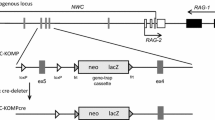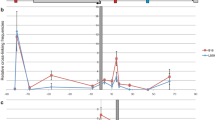Abstract
Expression of the human CL100 gene is induced in skin fibroblasts in response to oxidative/heat stress and growth factors. The CL100 gene encodes a dual specificity (Tyr/Thr) protein phosphatase that specifically inactivates mitogen-activated protein (MAP) kinase in vitro. In addition, CL100 is able to suppress the activation of MAP kinase by oncogenic ras in extracts of Xenopus oocytes. Thus, the CL100 phosphatase may play an important role in the negative regulation of cellular proliferation and is a likely candidate for a tumour-suppressor gene. Here, we show that DNA sequences homologous to CL100 are present in genomic DNA isolated from mouse, chicken, Xenopus and Drosophila, indicating that the CL100 gene is highly conserved. Using an assay based on the polymerase chain reaction, in conjunction with genomic DNA obtained from human-rodent somatic-cell hybrids, we have determined that the CL100 gene is situated on chromosome 5. Fluorescence in situ hybridisation using a CL100 genomic probe confirms that the CL100 mRNA is transcribed from a single genetic locus and maps the gene to 5q34.
Similar content being viewed by others
References
Alessi DR, Smythe C, Keyse SM (1993) The human CL100 gene encodes a Tyr/Thr-protein phosphatase which potently and specifically inactivates MAP kinase and suppresses its activation by oncogenic ras in Xenopus oocyte extracts. Oncogene 8:2015–2020
Charles CH, Abler AS, Lau LF (1992) cDNA sequence of a growth factor-inducible immediate early gene and characterisation of its encoded protein. Oncogene 7:187–190
Ding SF, Habib NA, Dooley J, Wood C, Bowles L, Delhanty JDA (1991) Loss of constitutional heterozygosity on chromosome 5q in hepatocellular carcinoma without cirrhosis. Br J Cancer 64:1083–1087
Ding SF, Delhanty JDA, Bowles L, Dooley JS, Wood CB, Habib NA (1993) Loss of constitutional heterozygosity on chromosome-5 and chromosome-17 in cholangiocarcinoma. Br J Cancer 67:1007–1010
Edwards YH, Parkar M, Povey S, West LF, Farrington FM, Solomon E (1985) Human myosin heavy chain genes assigned to chromosome 17 using a human cDNA clone as probe. Ann Hum Genet 49:101–109
Feinberg AP, Vogelstein B (1984) A technique for radiolabeling DNA restriction endonuclease fragments to high specific activity. Addendum. Anal Biochem 137:266–267
Fischer EH, Charbonneau H, Tonks NK (1991) Protein tyrosine phosphatases: a diverse family of intracellular and transmembrane enzymes. Science 253:401–406
Heisterkamp N, Groffen J, Stephenson JR, Spurr NK, Goodfellow PN, Solomon E, Carritt B, Bodmer WF (1982) Chromosomal location of human cell homologues of two viral oncogenes. Nature 299:747–749
Jones EA, Goodfellow PN, Kennett RH, Bodmer WF (1976) The independent expression of HLA and β2 microglobulin on human-mouse hybrids. Somat Cell Genet 2:483–496
Keyse SM, Emslie EA (1992) Oxidative stress and heat shock induce a human gene encoding a protein tyrosine phosphatase. Nature 359:644–646
Keyse SM, Ginsburg M (1993) Amino acid sequence similarity between CL100, a dual specificity MAP kinase phosphatase and cdc25. Trends Biochem Sci 18:377–378
Kielty CM, Povey S, Hopkinson DA (1982) Regulation of expression of liver-specific enzymes. III. Further analysis of a series of rat hepatoma X human somatic cell hybrids. Ann Hum Genet 46:307–327
Nabholz M, Miggiano V, Bodmer W (1969) Genetic analysis with human-mouse somatic cell hybrids. Nature 223:358–363
Nishida E, Gotoh Y (1993) The MAP kinase cascade is essential for diverse signal transduction pathways. Trends Biochem Sci 18:128–131
Noguchi T, Metz R, Chen L, Mattei MG, Carrasco D, Bravo R (1993) Structure, mapping and expression of erp, a growth factor-inducible gene encoding a nontransmembrane protein tyrosine phosphatase, and effect of ERP on cell growth. Mol Cell Biol 13:5195–5205
Phillips JR, Shepard EA, Povey S, Davis MB, Kelsey G, Monteiro M, West LF, Cowell F (1985) A cytochrome P-450 gene family mapped to human chromosome 19. Ann Hum Genet 49:267–274
Povey S, Jeremiah SJ, Barker RF, Hopkinson DA, Robson EB, Cook PJL, Solomon E, Bobrow M, Carritt B, Buckton KE (1980) Assignment of the human locus determining phosphoglycolate phosphatase (PGP) to chromosome 16. Ann Hum Genet 43:241–248
Rohan PJ, Davis P, Moskaluk CA, Kearns M, Krutzsch H, Siebenlist U, Kelly K (1993) PAC-1: a mitogen-induced nuclear protein tyrosine phosphatase. Science 259:1763–1766
Rooney DE, Czepulkowski BH (1986) Human genetics: a practical approach. IRL, Oxford
Sadhu K, Reed IS, Richardson H, Russel P (1990) Human homolog of fission yeast cdc25 mitotic inducer is predominantly expressed in G2. Proc Natl Acad Sci USA 87:5139–5143
Sartor H, Ehlert F, Grzeschik KH, Muller R, Adolphe S (1992) Assignment of two human cell cycle genes, CDC25C and CCNB1, to 5q31 and 5q12, respectively. Genomics 13:911–912
Senger GD, Ragoussis J, Trowsdale J, Sheer D (1993) Fine mapping of the MHC class II region within 6p21 and evaluation of probe ordering using fluorescence in situ hybridisation. Cytogenet Cell Genet 64:49–53
Solomon E, Bobrow M, Goodfellow PN, Bodmer WF, Swallow DM, Povey S, Noel B (1976) Human gene mapping using a X-autosome translocation. Somat Cell Genet 2:125–140
VanHeyningen V, Bobrow M, Bodmer WF, Gardiner SE, Povey S, Hopkinson DA (1975) Chromosome assignment of some human loci: mitochondrial malate dehydrogenase to 7, mannose phosphate isomerase and pyruvate kinase to 15 and probably esterase D to 13. Ann Hum Genet 38:295–303
Willman CL, Sever CE, Pallavicini MG, Harada H, Tanaka N, Slovak ML, Yamamoto H, Harada K, Meeker TC, List AF, Taniguchi T (1993) Deletion of IRF-1, mapping to chromosome 5q31.1, in human leukemia and preleukemic myodysplasia. Science 259:968–971
Author information
Authors and Affiliations
Rights and permissions
About this article
Cite this article
Emslie, E.A., Jones, T.A., Sheer, D. et al. The CL100 gene, which encodes a dual specificity (Tyr/Thr) MAP kinase phosphatase, is highly conserved and maps to human chromosome 5q34. Hum Genet 93, 513–516 (1994). https://doi.org/10.1007/BF00202814
Received:
Revised:
Issue Date:
DOI: https://doi.org/10.1007/BF00202814




